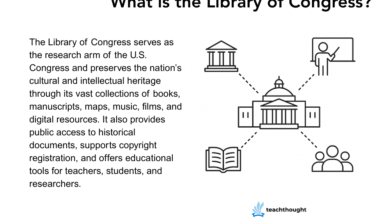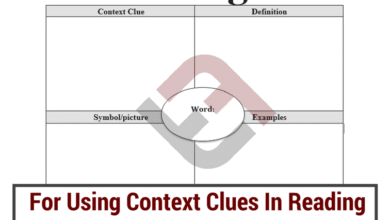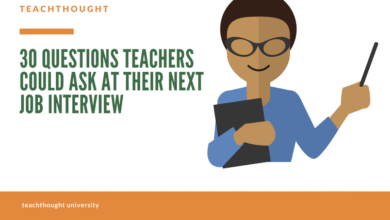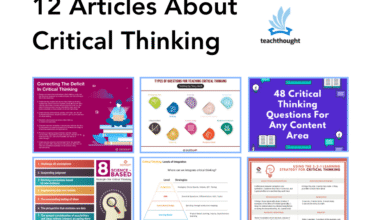Simple Ways to Put More Rigor in Your Lesson Plans
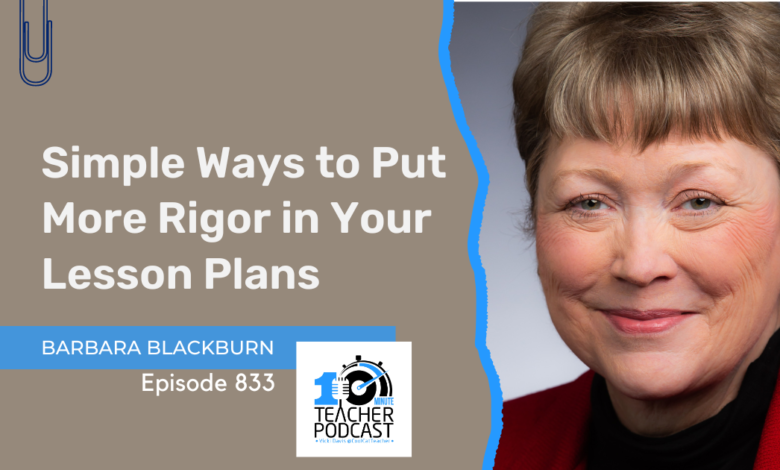
Hello there, fellow knowledge-seekers! You’re about to read a transcript that’s been generated by the AI in Adobe Premiere Pro and then me. I’ve gone through these lines like a cat chasing a laser pointer. But, even the best of us can be caught napping. Spot a mistake in this transcript? Help this teacher out and shoot an email to vicki at coolcatteacher dot com. Thank you for being helpful! – Vicki, your podcast host and friendly fellow classroom teacher.
Transcript
Vicki Davis (00:01)
Hello, we’re talking with one of my favorite experts, Barbara Blackburn. Her expertise is rigor, but hey, rigor is a good word, not a bad word, right Barbara?
Barbara Blackburn (00:13)
It absolutely is. You know, you can take any word and make it bad or good. It’s funny that you call me an expert. My dad, who died four years ago, always reminded me that I needed to stay humble when I was when I was doing a lot of different things. And he said, if you look at the word expert from an English perspective, Ex means former and spurt is a little drip.
Vicki Davis (00:26)
Mm-hmm.
former drip. Oh my goodness. Well, your 30 books and all of the work you’ve done, it makes you
more than a former little drip, but I do think that’s, your dad is funny. I’ll have to remember that one. So we’re talking about rigor, and I’m a classroom teacher and I want to put more rigor into my lesson plans. What does that mean? Does that mean a more detailed lesson plan? What does
Barbara Blackburn (00:44)
Thanks.
Well…
Vicki Davis (01:05)
putting more rigor when you’re consulting and working with teachers and saying, Hey, let’s, let’s reach every child. Let’s make this rigorous for every child. What does that? I think you have a rigor rubric, right? What does that rigor rubric look like and how do you help me teach in a more rigorous way?
Barbara Blackburn (01:17)
Mm-hmm. I agree.
Well, there’s actually two aspects of, if you’re talking about a lesson plan, because rigor is about having high expectations and that’s what the rigor rubric’s about and we’ll talk about that with some examples. But the higher your expectations in a true rigorous classroom, the higher the level of support. So you’re not just moving things up so that students can fail, you’re actually helping them get there. So in a good lesson plan, you’re really goingn to have the support.
to help them achieve that. So we’ll try to weave both of those together.
So let’s start with math, because math is one of those subjects that people say, okay, it’s already rigorous, students don’t understand it, or I need to just add some more problems, or, oh, I know what’ll make it more rigorous, I will do a word problem. Well, so here’s the thing. So here’s the thing, we’re doing computation, we’re doing two plus two equals four, we’ll go with something pretty basic.
Vicki Davis (02:12)
Oh.
Barbara Blackburn (02:21)
And then we do word problems. So we do, I have two dogs and my sister has two cats. Well, you’ve made the reading rigorous, I guess, but you really haven’t made the math more rigorous because you’re still doing computation. So I’ll have teachers who’ll come back to me and say, I have already solved that problem. I asked my students to write their own word problems. So that’s great. So here’s what happens. The students write a word problem. I have two cheese pieces of pizza and my brother has two mushroom pieces of pizza. How many pieces of pizza do I have?
All right, they had to write, so that’s maybe rigorous, but they’re still doing basic computational skills. None of that is rigorous. So in a math classroom, and again, what I try to do when I’m working with schools and districts is be very detailed with what this looks like with the rubric, is in a math classroom, rigor is going to be something like identifying and explaining misconceptions. So maybe I’ve got my addition problems.
Vicki Davis (02:55)
Mm.
Okay.
you
Barbara Blackburn (03:17)
and I’ve got a couple of word problems, whatever I’ve got. But then what I’m going to have is one problem where I give students three problems, addition problems that are already solved. They have to figure out which one is incorrect, explain why it’s incorrect, solve it correctly, and then explain why it’s correct now. Do you see how that is just so much more rigorous?
Vicki Davis (03:31)
Oh.
Oh
It is because, you know, for example, in math, you know, basically the ACT has accused schools of grade inflation, right? And saying that we’re inflating grades because the kids take their ACT or SAT and they don’t know math, but they’re making high grades and, you know, I taught to my students about this and, you know, a lot of them say, my parents have a photo math pro and so they’re checking their answers, but they’re not checking their process and this requires a true understanding of the process to solve.
a math problem. That is awesome.
Barbara Blackburn (04:16)
Okay, so let’s take it a step further. So you’ve got students with special needs, okay, who can’t do that. You know, the teacher says they can’t do that. That’s just too much. Well, here’s what I’m goingn to do. Well, first of all, I’m goingn to have, with everybody, I’m going to have modeled this and we’re goingn to have done some together. You’re never just goingn to throw them into it by themselves. But with my students with special needs or my other struggling students, I’m not goingn to give them three to choose from. I’m goingn to give them two to choose from. And they still have to do the same things.
So it’s not that I am ignoring them, I am supporting them. And let’s flip it around. What do you do with those advanced students who are going, this is pretty easy? Well, I may give them five problems to pick from and they don’t know how many are incorrect. So I can differentiate in some really interesting ways, but still teach the same rigorous strategy. And so it’s not, rigor’s not more, rigor’s not different.
Vicki Davis (05:03)
Wow.
Barbara Blackburn (05:15)
Rigor is really good teaching. That is what it is. I mean, and you can tell how passionate I am about rigor. I love rigor because it is something that makes a difference for kids.
Vicki Davis (05:26)
It does. And, you know, as we’re talking about this, one of the things as I work with schools about artificial intelligence that I talked to them about is how can we bring the process of what you’re trying to teach to the forefront? Because when we overemphasize on the product and we let kids just do it on their own, you know, AI can get them the product, but it can’t teach them the process necessarily. That has to happen through productive struggle and through, you know, there’s just a lot of things that help that happen.
And this is helping focus, bring that focus back on the process. I love this. Now, what would this look like in a, in a literature or writing class?
Barbara Blackburn (06:03)
Okay, I’m so glad you asked that because that was goingn to be my next example. So in a literature class, typically what we do is we have them read something, whether it’s text, a short story, a novel, whatever, and we have them answer questions. And to make it more rigorous, we write higher order questions. Okay, well that’s fine, but the process there is they’re just looking back and looking for answers. Now, maybe it’s explicit,
Vicki Davis (06:24)
Mm-hmm.
Barbara Blackburn (06:33)
or maybe it’s implicit, which is a little more rigorous, but you’re really not making it as rigorous as you want to. So again, I’ll have teachers will say to me, okay, but now here’s what I do. They don’t just answer the questions. They have to provide evidence. Okay, well kudos to you because that’s a really good thing. But here’s the thing. If all I’m doing is looking in the text and providing evidence, I’m still not taking it to that next level. So what you want to do in any kind of, not just in English classroom, this could be a science classroom, a social studies classroom.
Vicki Davis (06:50)
Mm-hmm.
Mm.
Barbara Blackburn (07:03)
is be able to demonstrate you understand the text, but also go beyond the text. So maybe you go beyond it with a real life connection. Maybe you go beyond it with a connection with another book you’ve read. Maybe you go beyond it with something that’s happened in your family life, but you go beyond the text because if all you do is stick to the text, you’re never getting out. And those connections are important. Maybe you connect to a science classroom.
Maybe you connect to something you learned last year, but you want to really take that text and go beyond it to make that rigorous. Does that make sense?
Vicki Davis (07:41)
It absolutely does. And I have one of the best English language arts teachers I’ve ever seen who teaches across the hall from me. Her name is Dawn Beck and she will often at the end of a, um, a book, say, select a problem from the book and relate it to something that’s happened in your own life. And that would be the topic of what they would be writing, which honestly, a lot of this has happened as a result of artificial intelligence because artificial intelligence can’t write a paper.
relating to your life. Like you could really work forever on a prompt, but by then you’ve written a paper, right? So, but relating it to a person’s life and then also she would have them related to other books they’d read. So they’re having to on multiple fronts relate and show comprehension of what had happened in multiple books. But you’re saying that approach improves the rigor and demonstrates that they understand the text.
Barbara Blackburn (08:37)
Yes, particularly when they have the evidence with it. So if I say that this applies to my life because I had a friend who died last year, I need to not just say that, I’ve got to provide not evidence that she died, but evidence of how that impacted my life. So real life examples. See what I’m saying? It’s not just a sentence.
Vicki Davis (08:41)
Okay.
Mm.
Oh, so, yeah. So you say you don’t just state the fact, you state the emotions, the things around that fact that would relate it to what the description in the book.
Barbara Blackburn (09:08)
Yes, yes, it can be emotions, it can be facts, it can be feelings, it can be specific actions. And you know, going back to what do you do about the students who you’re sitting there going, I’ve got students who couldn’t do this. Well, a graphic organizer is my friend here. So I’m going to give them a graphic organizer that they’ve got spaces to write emotions, to write facts, to write the different things. So they’ve got something to pull from before they actually try to write their paragraph or essay.
Vicki Davis (09:10)
It’s fascinating.
Hmm.
Mmm.
Barbara Blackburn (09:38)
Because if I can structure for them what that needs to look like they can download it out of their brain But if I just say write the essay, they’ve got a blank sheet of paper. That’s just too much
Vicki Davis (09:38)
Yeah.
Yeah, that pre-writing is such an important part. And another thing Dawn does, it sounds like we need to pull Dawn into this conversation is she actually has like a board, a post-it note where they’re like, you know, brainstorming and then they move to outlining and then they move to first draft and they’re actually moving that little and they’re doing it in class so that she’s seeing the writing process. Because again, it’s folks who are just having kids write at home for seven days and bringing the essay.
Barbara Blackburn (09:53)
I’m sorry.
Mm-hmm.
Vicki Davis (10:14)
on many levels we’re missing out on instructional opportunities.
Barbara Blackburn (10:19)
Oh yeah, I mean, I did that when I was teaching at the university level. I taught mainly graduate students, teachers coming back to get a master’s degree. And they wrote a research synthesis paper that was very high level. It very much prepared them for doctoral level work. It was something they’d never written before. And with them, okay, teachers, with them, we chunked it. You know, they would have to come in with their topic and we would talk about the topics and everything. And then they would have to come in another night with what they thought their subheadings were goingn to be after they had pulled together their.
Vicki Davis (10:40)
Hmm.
Barbara Blackburn (10:49)
I mean, we did that together so that, you know, by the time they had a draft, then they met with me individually and then they were successful at the end. And what all of them said was, well, this was really hard. They wanted t-shirts that said I survived Dr. Blackburn’s synthesis paper. But, uh, they also said, you know, you made it so we could be successful because
Vicki Davis (11:11)
Mm-hmm.
Barbara Blackburn (11:12)
I guess to me the frustration and understand that part of my bias, I’ve taught a little bit of everything with grade levels. I’ve taught a little bit of everything with levels from honors down, but the bulk of my teaching time was with at risk students and they needed people who believed they could.
Vicki Davis (11:24)
Hmm.
Ah, agreed.
Barbara Blackburn (11:32)
That’s what they needed more than anything else. And so my bias is very much toward that. So that’s a big deal for me. I just, I find that because people will say, well, rigor, these students just can’t. Yes, they can. You have to choose to help.
Vicki Davis (11:40)
Mm-hmm.
They can. Well, and sometimes it’s the thinking process before the creation process starts. You know, when my students are creating apps, I’ll have kids who say, oh, I can’t make an app. No, let’s don’t make an app yet. Right now we’re talking about a need in the world that needs to be addressed. And I had some ladies that won our shark tank from last semester and it was on mental health. And they said they couldn’t make an app and it won. And…
we sat down and we’re like, okay, what is a problem? They’re like, well, you know what? Girls need to understand that they’re okay, that life is not Instagram. They need to know how to get help. They need to know what problems look like and a good view on, you know, that they’re not alone, you know, and they’re talking about problems. And then they designed an app that would meet those problems and help those problems. And so we did the thinking verbally between us, kind of like you did with your grad students.
that took them to a whole level and those girls, which most of them actually didn’t like to write, one was English with a second language, spent forever writing that piece and it was just gorgeous, beautiful and well written because we had engaged their thinking in the conversations beforehand.
Barbara Blackburn (13:03)
And see, that’s what teaching is all about. You know, sometimes I think that we’ve gotten so busy. I don’t think it’s teacher’s fault, okay? I think that the system, we’ve gotten so focused with testing and so busy and trying to deal with the whole COVID and the recovery from that and just having too many kids sometimes and everything else, we get so busy with that. We miss those moments that are really important.
Vicki Davis (13:06)
Mm-hmm.
Hmm. Yeah. Yeah, they are really important. Well, we talked about so much, but I’ve got to do this. We’ve got a tad over our 10 minutes.
Do you have something quick for our science teachers and history teachers so they’re not left out?
Barbara Blackburn (13:44)
Okay, history teachers, looking at changes over people, places, and time. That’s sort of the strategy to look at. So really looking at over time, make sure you’re going beyond the text, make sure you’re doing evidence, things like maybe you look at something in history, but you also are applying it to what would happen in today’s world with that. Oh, there’s just so many good examples.
Science, biggest thing in science, we have them do all kinds of experiments. And in science, if you want to up the rigor,
They need to, and you can do this in a class discussion, you need to come up with topics, and students need to, and this can be in groups, come up with their own research questions, and they have to design their own experiments. Instead of us giving them an experiment, they design their own. And then they write up their conclusion with evidence from the data and what they learned from the research. So those are two really quick ones.
Vicki Davis (14:27)
Mm.
Wow. And you have so many books that can help us on this topic. Barbara Blackburn, you just, you always teach me so much. You’re one of those podcasts that I actually re-listen to my own podcast with you on them. And I will link in the show notes to what I’ve had you on before, because I always learn so many practical things. And you know, that’s just something in these days for me as a classroom teacher is just focusing on the
practical.
what it really looks like in today’s world because so many things have changed so rapidly that we’ve got to get, get to where we’re just focusing on excellent teaching and really bringing that process back into the classroom where we are talking about what we’re trying to teach and we’re focusing on the process. So thank you Barbara Blackburn for coming on the 10 minute teacher.
Barbara Blackburn (15:24)
You are welcome and I know you’re going to put my website address on there which has got over 100 free resources for people so lots of stuff on the website. Thank you.
Vicki Davis (15:31)
Oh, that’s awesome. Awesome, thank you.
